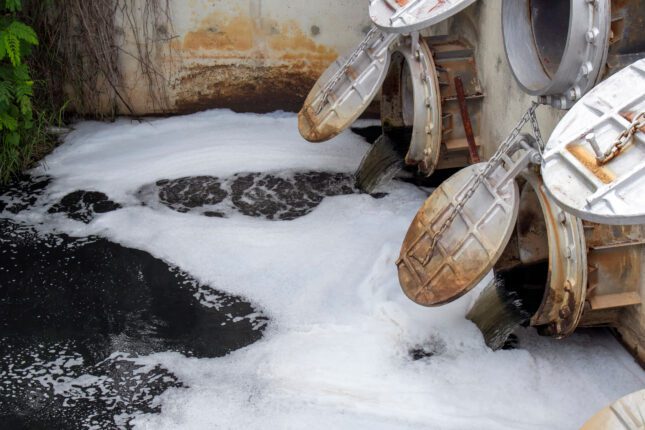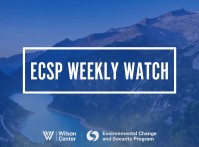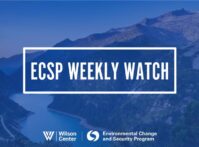-
Toxic Threads: Southeast Asia’s Textile Pollution Poses a Growing Security Threat
August 11, 2025 By Md Mursalin Rahman Khandaker
In today’s world of fast fashion, a $4 crop top travel across continents faster than a letter, and new trends die before a customer hits the “checkout” prompt. Yet the global obsession with cheap clothing creates apparel soaked in a cocktail of dyes, plasticizers, and forever chemicals, that linger far longer than the consumer forces that make them trendy.
The global apparel sector is valued at over $1.8 trillion, and it is the world’s second most chemical-intensive industry after agriculture. For big manufacturing hubs in Southeast Asia (particularly India, Bangladesh, Pakistan), textiles represent an economic lifeline.
Yet the process needed to obtain economic success requires thousands of complex chemicals used in dyeing and finishing, which also fuel a steady flow of untreated or under-treated effluent. The pervasive threat of this inflow damages everything from drinking water to coastline environments.
Taken together, the chemicals used so abundantly in the textile industry have created a security issue that directly translates into human and environmental insecurity The probable resulting impacts include increased rates of cancers and hormonal disorders, devastation of aquatic ecosystems, the collapse of small-scale agriculture and fisheries, and an erosion of trust in public institutions tasked with implementing regulations.
Safety Versus Security: A Blind Spot in Global Oversight
Chemical safety is designed to protect people and the environment, and it is frequently discussed and practiced in industries that deploy them in significant amounts. Yet chemical security is often overlooked in the global apparel sector, despite the fact that it should be at the center of discussions in the region.
Chemical security goes far beyond the realm of industrial or workplace safety. It examines systemic and intentional misuse of chemicals, the persistent environmental pollution they cause, and the implications of their use and misuse for communities, ecosystems, and geopolitics.
Apparel items produced in the textile industry carry a number of complex chemicals – including dyes, heavy metals, and “forever chemicals” such as per- and polyfluoroalkyl substances (PFAS) – which create potential security risks. Especially in Southeast Asia, textile production has become a vector for prolonged and multi-layered chemical insecurity.
Most observers are familiar with the established conventional chemical security frameworks that aim to prevent the misuse of dual-use chemicals for terrorism or warfare. The Chemical Weapons Convention (CWC) focuses on eliminating chemical weapons under the Organization for Prohibition of Chemical Weapons (OPCW)’s oversight, while the Chemical Security Program (CSP) secures high-risk facilities and limits access to explosive precursors.
The threats emanating from the global apparel sector are quite different. Despite having robust chemical safety practices in practice, the textile industry’s production processes involve the large-scale, ongoing release of harmful substances such as azo dyes, PFAS, phthalates, chromium compounds, and formaldehyde. And although these chemicals are not intentionally weaponized, regulatory neglect, weak enforcement, and a lack of global focus mean that their combined effect on public health, ecosystems, and food chains stemming is concerning.
The CWC and CSP were designed to protect against sudden, high-profile chemical misuse in open conflict, but the chemical insecurity created by the textile industry undermines broader environmental and human security without triggering similar global alarms.
Rising cancer rates, reproductive health issues, loss of livelihoods in farming and fishing communities, and deepening economic inequality involved in apparel productions are key elements in the overall threat to human security. The environmental security dimension of the challenge is anchored in a continuous degradation of the ecosystem, declining resilience to climate shocks, and the transboundary spread of persistent pollutants that destabilize shared resources such as river basins and oceans.
Silent Spill: How Southeast Asia’s Textile Hubs Leak Risks
Zeroing in on flashpoints of chemical insecurity furthers our understanding of the crisis. In Southeast Asia’s key textile areas, for instance, uncontrolled chemical discharges pose risks to the environment and public health.
The city of Tiruppur is known as India’s “Knitwear Capital,” and its industries have historically released untreated dyeing waste into the Noyyal River, thus damaging agricultural land and groundwater. Fluoride contamination in groundwater here is a serious issue which is linked with chemicals released from the city’s textile industries, as Combined Effluent Treatment Plant (CETP) performance varies, smaller units often ignore existing regulations, and enforcement is weak.
In Faisalabad, which is Pakistan’s largest textile area, factories release effluent into the Chenab River. Studies have shown high pH levels, low dissolved oxygen, elevated BOD, and unsafe amounts of chromium and copper in the local water, soil, and plants. And despite measures including the Pakistan Environmental Protection Act (1997) and National Environmental Quality Standards (NEQS) in place, enforcement suffers from a lack of technical and financial resources.
Major Bangladeshi textile clusters including Gazipur, Narayanganj, and Chattogram show significant river contamination from heavy metals (Cr, Cd, Pb) and PFAS. Some pollutant levels in the region’s bodies of water are hundreds to thousands of times above safe limits. Health risk assessments also indicate that chromium exposure poses a serious non-carcinogenic threat. A CORVI assessment on Chattogram in 2023 revealed medium-high risks in Geology, Water and Climate Change indicators. And although the Bangladesh’s Environmental Conservation Rules (ECR 2023) introduced stricter discharge standards two years ago, many factories still lack functioning Effluent Treatment Plants (ETPs), and also cite high compliance costs as a major barrier to meet these new requirements.
The consequences of local chemical insecurity are far-reaching. Polluted rivers such as the Buriganga, Karnaphuli, Noyyal, and Chenab carry heavy metals, azo dyes, PFAS, and other contaminants into major waterways, where they eventually reach the Bay of Bengal or Arabian Sea and trigger marine dead zones. Grayscale textile exports also may be tainted, exposing brands to trade restrictions, regulatory penalties, and reputational losses. Meanwhile, polluted water and compromised agriculture threatens public health and environmental displacement, as vulnerable populations are compelled to migrate in search of safe living conditions and income.
Compliance and Reporting Initiatives Seem Insufficient
Despite regulations on the books to help counter the factors that create chemical insecurity, Southeast Asia’s textile sector faces structural gaps that continue to expose the region’s people and environment to these risks. Two issues are at the heart of the problem: financial constraints for small and medium enterprises (SMEs) and a lack of transparency.
In India and Bangladesh, compliance mechanisms such as Zero Liquid Discharge (ZLD) and mandatory Effluent Treatment Plants (ETPs) have been created without considering the limited resources available to SMEs. Without access to affordable financing, technical help, or the opportunity to build economies of scale, smaller enterprises often cannot afford to comply with regulations. And in areas without the subsidized Common Effluent Treatment Plants (CETPs) available in Tiruppur, SMEs must shut down or operate informally, releasing untreated waste into rivers, canals, and groundwater, with potent effects on community health and local economies.
Global platforms like ZDHC, GOTS, and OEKO-TEX do provide guidelines and certifications privately that could make a difference. Yet participation in these programs is inconsistent and voluntary. For instance, fast fashion brand “Shein” often skips these standards due to their costs and the complexity of supply chains. Additionally, regional governments do not provide centralized, real-time, and accessible data on industrial discharges. It is a lack of transparency that not only makes enforcement reactive, but also weakens trust in regulatory systems.
Building Chemical Security from the Bottom Up
Improving chemical security in Southeast Asia’s textile sector requires stronger regulation and clearer, standardized sustainability reporting. Gaps in accessibility and expertise limit these efforts.
International frameworks such as the Global Reporting Initiative (GRI), Sustainability Accounting Standards Board (SASB), Carbon Disclosure Project (CDP), and Higg Index do provide tools to track environmental impacts that include chemical traceability and environmental pollution. Yet private companies often use these standards selectively to enhance brand compliance and visibility to investors. Rarely are these tools integrated into national regulatory systems, and the data provided is self-reported and usually deemed to be proprietary material.
It is vital to embed reporting standards into national policies to make transparency an effective tool for chemical security. It will also require that governments train local agencies in data interpretation, and require international brands to share audit and traceability data with regulators in manufacturing countries. These steps would protect communities, ecosystems, and the credibility of regulatory systems.
While development institutions and banks can offer financial and technical support, real change will rely upon increased consumer responsibility and brand accountability. Major fashion brands sourcing apparel from Southeast Asia must go beyond stringent facility-based audits and engage more closely in collaboration with manufacturing countries under national chemical safety and environmental guidelines.
For instance, instead of running separate, brand-led monitoring systems, global buyers could help create centralized digital dashboards and common traceability platforms to make industrial pollution data accessible to regulators and communities. Green labeling programs (e.g. ecolabel), Environmental and Social Governance (ESG)-linked financing, and public awareness campaigns can further connect consumer behavior with production impacts, and encourage higher demand for verified, low-impact clothing.
If fast fashion continues to shift chemical risks onto communities near rivers like the Noyyal, Karnaphuli, or Chenab, true sustainability will remain unattainable. Yet making the right choice to take fast fashion out of fashion will not happen overnight. Combining financial incentives, coordination in transparency, local government support, and consumer-driven accountability will allow stakeholders to transform the apparel industry from a source of chemical insecurity to a catalyst for cleaner and more circular economies. Textile pollution is a human and environmental security challenge. The time to change that dynamic is now.
Md Mursalin Rahman Khandaker is an Environmental Security Intern at the Stimson Center. He has an MS in Science, Technology and Environmental Policy from the Humphrey School of Public Affairs, University of Minnesota Twin Cities. Mursalin has spent 5 years in the ESG space of textile and leather industries in Bangladesh, consulting on chemical management, water and waste management, and decarbonization of the supply chain
Sources: Arms Control Association; Chemical Security Program; Bangladesh Department of Environment; Ecolabel Index; Ecotoxicology and Environmental Safety; Cascale; CDP; Encyclopedia; Environmental Challenges; the Financial Express; Global Organic Textile Standard; Global Reporting Initiative; GM Insights; the Guardian; Gulf Hypoxia; IFRS Foundation; International Journal for Research in Applied Science and Engineering Technology; IPEN; Journal of Chemical Education; National Assembly of Pakistan; OEKO-TEX; Organization for the Prohibition of Chemical Weapons; Pakistan Environmental Protection Agency; Recovo; Road Map to Zero; Sweden Textile Water Initiative; Toxicology and Environmental Health Sciences; Wastewater Treatment Plants as Biorefineries; World Health Organization.
Photo Credits: Licensed by Adobe Stock.
 A Publication of the Stimson Center.
A Publication of the Stimson Center.








